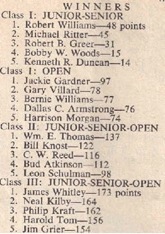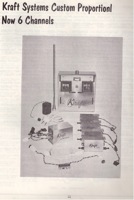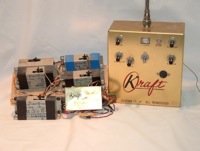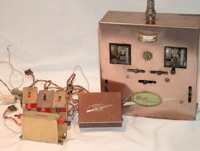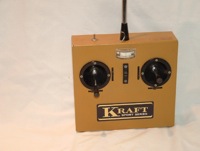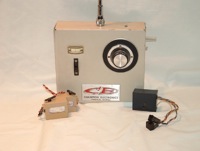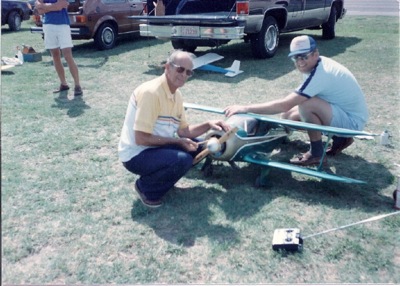Company History
Champion Electronics
By: Craig JourneySeptember 2009
I am Craig Journey, and have been in RC modeling since I was in junior high school in the late 1950’s. The story of Champion Electronics can only be told in the context of the life of my Uncle Neal B. Kilby (1924 to 1996) of Chamblee, Georgia. He was the creator of the product line, and was also a life long modeler.
Neal taught me to model in the days of single channel escapement and pulse systems, and he became very skilled in the building of the early radio equipment. Having no electrical higher education was no hindrance, and Neal achieved a Ham Radio license as he gained both radio and building skills. He followed the progression of RC electronics from single channel escapements to pulse to multi-channel reed relay equipment. Neal became a skilled pattern flyer with his favorite Taurus and Kraft Custom 10 channel reed system.
In 1966 Neal, went to the AMA Nationals and placed second behind James Whitley of Decatur, Alabama and his now famous Daddy Rabbit. Third place was taken by Phil Kraft. All three flyers were using the then brand new Kraft digital proportional radio equipment as pictured here in a 1966 Ace catalog.
As Champion of Chamblee gathered financial success and market share they began to look at other areas where they could market new products. They looked at kitting an RC pattern plane they called the Widget and also into building radio equipment. The advent of reliable proportional equipment and the market rush to the new technology was seen as a market opportunity, and Neal began to develop a proportional system while at Champion of Chamblee.
By the end of 1967, Neal had been able to leave the slot car business and start his own radio company which he called Champion Electronics. His facility was located in a house in the Chamblee, Georgia area. There he hired a young electrical engineer and began to put the final problems to bed before production.
The transmitter was almost identical to the Kraft new series radio to be introduced in 1968. It used enclosed sticks (Kraft Hayes design) in a white vinyl case. It was capable of five (5) proportional channels and employed a center loaded antenna.
The receiver was a new approach in design and packaging. It was not a double deck design nor single pc board, but rather a board and a third. On the main board was the super heterodyne single conversion receiver of the latest state of the art. It was nothing radical but was well proven and stable. It was in the area of the signal decoding that Champion was on the leading edge of technology. The decoder board was a third size board which could only be done by using two (2) digital TTL logic devices. The TI SN7441A BCD decoder was driven by a Motorola MC838P binary counter. Three pulse amplifiers and a sync circuit completed the decoder design and were located on the main receiver board. The completed receiver was 1.875 inches by 1.5 inches by .875 inches and was truly capable of nine (9) channels, if such a transmitter was ever available. The receiver was small with respect to the other units available at that time.
Kraft servo connecting blocks added the final receiver interface. The servos offered were from two (2) sources according the sales literature. The Orbit PS3 as one and the Kraft KPS-10 was the second. The choice of the KPS-10 is important to dating the early production of the Champion Electronics “PATTERMASTER” RC system. The Kraft history line shows that the KPS-10 was a 1967 design item reaching production in volume during the 1968 production year. I don’t know the breakdown on which servo was the most common, but I suspect the success of the Kraft KPS-10 made it the most popular option. It is easy to note the Kraft influence in the “PATTERNMASTER” as seen in the many Kraft parts which were employed.
The following is a schematic of the receiver; note that the actual radio part had no schematic details as it was such a well developed item in its own rights and would have looked like almost all receivers of that day. The decoder is detailed with component values.
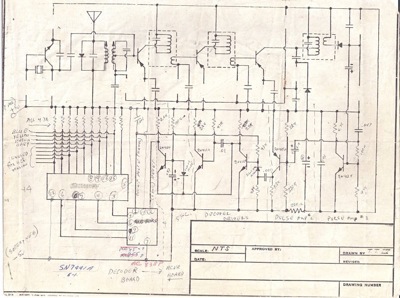 |
I know that Neal continued his contest flying using his new radio design, and as there is a total lack of advertising in the model airplane magazines I would assume that his marketing thrust was by one on one at the pattern contest of his day.
There are no production records remaining for the Champion Electronics brand and I estimate that the production stopped in the very early 1970’s. These units were all hand built by Neal and maybe one or two other people. I would venture to say that only a few hundred were ever built. By 1970 many manufactures were in the market place along with kits for the do-it-yourself modelers, all of which was driving down the system cost. Kraft was the market leader, leaving little room for low volume production units.
In September 2009, I traveled to see my aunt who still lives in the greater Atlanta area. I ask if I could see my uncle’s shop area which my aunt said she had not been in since his death. There I found and retrieved several boxes of very old radio equipment that he had kept for 30 years or longer. I have researched several units and have made a case for why he had kept them for all these years.
The Kraft Custom 10 was a radio I had helped Neal rebuild in 1995 for the SPA (Senior Pattern Association) events. I suspect that this ham radio band system went back to the early 1960’s and was the radio he learned and mastered for pattern flying in that period. When I got the unit for refurbishing the only thing I needed to do was add modern NiCad batteries and the radio link came to life. The servos were a different issue, as most of the electric motors were not working. It was not many days after I told him about the servo motors that I received a large box full of old Bonner Transmite servos. Luckily I found enough motors to yield five servos. The radio was put into an original period plane called the Pegasus. I only assume that the plane did make it back into the air after nearly
This PCS system dates back to the mid 1960’s and I am sure was very similar to the Kraft system he flew in the 1966 Nats. Note that the transmitter had an original Kraft decal applied to the front over the PCS logo. The history of Kraft and PCS may indicate the meaning of the Kraft decal. As this unit was set-up as Mode I, I believe this is Neal’s radio from this period because he only flew Mode I.
This just looked like so many 1970’s Kraft transmitters at first. When I looked, I saw that the serial number 11068. This places this unit in very early 1968 production. This would be about the time of the introduction of the “PATTERNMASTER”. It is interesting to note that Phil Kraft won the world championships in late 1967, and after that win he placed the name “Gold Medal” on his equipment. The production of this radio must have been before the tooling for the label with the new name was ready.
The last and most important find for me in my uncle’s shop was a Champion Electronics transmitter, receiver and two Kraft 10 servos. I had never physically seen one of his units before. It was evidently a prototype unit for a single stick configuration. While the transmitter encoder was of a four or five channel design with all channels populated, it was not a true single stick as expected. The stick only had a left-right function and no up-down operation. The elevator was located on the right side of the case and was spring loaded to neutral. There were two trim levers seemingly for left-right and up-down trim. This accounted for two channels, but nowhere was there a throttle lever. This could indicate a sail plane 2 channel mode but I am not sure. The case is of a crude fit showing its prototype nature. The levers were all hand cut plastic but the case holes for the levers were all machine cut. The antenna and servos all had a Champion of Chamblee aluminum printed label affixed to them.
This history of Champion Electronics was made possible by many telephone calls with Neal’s close friend Fred Chastain and from a 2009 search of Neal’s shop. The real tie back was the connection of Neal and Champion of Chamblee slot cars. The history here is well documented on the internet and placed a time line along side the facts of the creation of Champion Electronics.
Here is one the last pictures of Neal and me taken in 1987 at a local field in the greater Raleigh, NC area where I live. He told me that the Stagger Wing was always one of his favorite models. I remember very little about it but from the picture it looks like he was still using a Kraft radio at that time.



